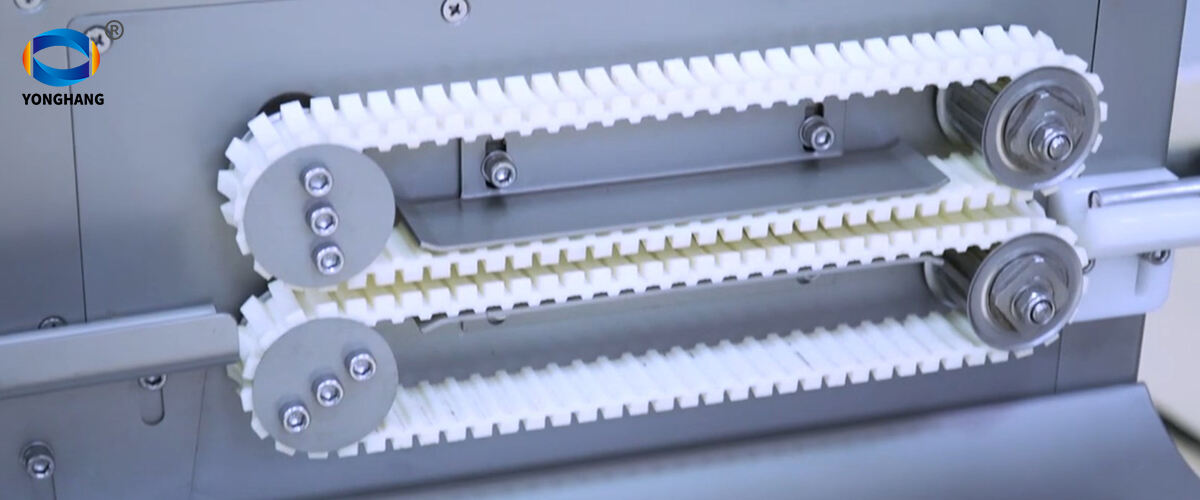Thermoplastic vs. Rubber-Based Sausage Belts: Pros and Cons
The sausage belt is mostly constructed of thermoplastics (rubber compounds and TPU). According to Food Processing Journal 2023, thermoplastic belts can lower mass-to-strength ratios by 34% vs. rubber for less energy use. Its non-porous design makes it difficult for bacteria to stick around and at the same time, sustains a 80-90 Shore A hardness which provides grip. But as we will see in the next section, rubber types are far more common at high flex than TPU, being somewhat less elastomeric (recovering 92% of elongation vs. TPUs 85% — ASTM D412).
Reinforcement Layers and Tensile Strength for Long-Term Durability
High-performance belts integrate aramid fiber grids achieving 300 N/mm² tensile strength – triple EN 20345:2022 requirements. This prevents stretch deformation under 1,200kg/m loads common in smoked sausage production. Engineered reinforcement reduces edge delamination risks by 61% compared to single-material designs (Meat Industry Engineering Report 2024).
Impact of Manufacturing Standards on Sausage Belt Longevity
ISO 22000-certified belts demonstrate 40% longer service intervals than uncertified alternatives. Precision vulcanization maintains ±0.15mm thickness tolerance across widths up to 1,200mm, critical for preventing tracking issues. A 2023 European processor audit revealed ISO-compliant belts required 73% fewer unscheduled downtime events.
Key Polymer Materials: TPU and FDA-Compliant Food-Grade Polymers
Thermoplastic Polyurethane (TPU) dominates 68% of new installations due to its -40°C to 125°C range. FDA 21 CFR §177.2600-compliant additives enable resistance to lipid penetration (>24hrs @ 60°C) and CIP chemicals. Advanced polymer cross-linking now supports 3-year warranties in standard environments.
Non-Porous and Seamless Designs to Prevent Bacterial Ingress
Premium belts use monolithic construction without seams. TPU formulations with <0.5μm surface roughness reduce bacterial adhesion by 73% versus rubber (Journal of Food Protection 2023). Electropolished finishes eliminate microscopic crevices while maintaining flexibility.
CIP Compatibility and Rapid Cleaning Features of Sausage Belts
CIP-compatible belts withstand 80°C alkaline washes and high-pressure sprays (15-25 bar) without delamination. The Food Manufacturing Efficiency Report 2024 showed smooth-backing belts reduced cleaning cycles by 32%. Key features include:
- 360° edge sealing
- Chemical-resistant top coatings
Pathogen Resistance and Antimicrobial Treatments in Food-Grade Belts
Silver-ion technologies inhibit biofilm formation for 72+ hours (ISO 22196). Copper-infused TPU shows 99.7% E. coli reduction in 4 hours (International Journal of Food Microbiology 2022).
Case Study: Reducing Listeria in European Meat Processing
A German processor achieved 62% lower Listeria rates after switching to antimicrobial TPU belts:
| Metric | Before | After 18 Months |
|---|---|---|
| Swab positives/month | 8.7 | 3.3 |
| Product recalls | 2 | 0 |
(EFSA Annual Meat Safety Report 2022)
Thermal Resilience in Cooking and Chilling Stages
Belts maintain elasticity between -40°C to 125°C. A 2023 study found TPU showed 34% less dimensional variance than rubber after 500 temperature cycles.
Resistance to Fats, Humidity, and Harsh Cleaning Agents
Advanced belts combine:
- Fat-resistant polymers (<0.1 kV/m static dissipation)
- Phthalate-free plasticizers (≤15% moisture absorption)
- Peroxide-cured rubber (pH 14 resistance for 1,000+ hours)
High-Temperature TPU Belts: A Growing Trend
| Property | Rubber | Advanced TPU |
|---|---|---|
| Continuous heat limit | 85°C | 125°C |
| Oil absorption | 12% | 3.8% |
Real-World Data: Failure Rates Above 80°C
At 80°C:
- Rubber belts: 12% failure/1,000 hours
- Reinforced TPU: 2.1% failure rate
Abrasion Resistance in High-Speed Production
TPU belts show:
- 82% less particle contamination vs rubber
- 40–60% longer service life
- 6.2 million cycles before 1mm wear (2023 Material Durability Report)
Load Distribution and Edge Wear in Continuous Operations
Optimized belts reduce:
- Edge wear by 40%
- Energy consumption by 18%
Dynamic Stress Testing and Industry Certification Standards
| Test Parameter | Benchmark | Premium Performance |
|---|---|---|
| Flexural Fatigue (cycles) | 500k | 1.2M |
EN 20372:2020 certified belts show 34% lower failure rates.
Predictive Maintenance Strategies
Wear indicators provide 8–12 weeks' replacement notice. Plants report:
- 64% less unplanned downtime
- 22% longer belt lifespan
Matching Belt Texture and Thickness to Sausage Type
Stage-specific belts reduce defects by 18%:
- Fresh sausages: 0.8-1.2 mm smooth belts
- Coarse-ground: 2.0-3.5 mm textured
Essential Certifications
Key standards:
- FDA 21 CFR 177
- EU 1935/2004
- ISO 22000
Certified belts reduce contamination by 40%.
Total Cost of Ownership
| Cost Factor | Premium Belts | Economy Belts |
|---|---|---|
| Annual replacements | 0.7 | 3.2 |
| Sanitation downtime | 12 hrs | 41 hrs |
FAQ
What are the advantages of using TPU over rubber in sausage belts?
TPU offers better thermal resistance, a wider range of operating temperatures, and reduces bacterial adhesion due to its non-porous surface. It also supports longer service intervals and less energy use compared to rubber.
How do reinforcement layers impact the durability of sausage belts?
Reinforcement layers such as aramid fiber grids increase tensile strength, prevent stretch deformation under heavy loads, and reduce the risk of edge delamination, ultimately enhancing the belt's longevity.
What certifications are important for sausage belts?
Important certifications include FDA 21 CFR 177, EU 1935/2004, and ISO 22000. These standards ensure the belts are safe for food processing, provide consistent performance, and help reduce contamination risks.
How do antimicrobial treatments in sausage belts work?
Antimicrobial treatments use silver-ion technologies and copper-infused TPU to inhibit biofilm formation and reduce bacterial presence, providing a safer food processing environment.
Table of Contents
- Thermoplastic vs. Rubber-Based Sausage Belts: Pros and Cons
- Reinforcement Layers and Tensile Strength for Long-Term Durability
- Impact of Manufacturing Standards on Sausage Belt Longevity
- Key Polymer Materials: TPU and FDA-Compliant Food-Grade Polymers
- Non-Porous and Seamless Designs to Prevent Bacterial Ingress
- CIP Compatibility and Rapid Cleaning Features of Sausage Belts
- Pathogen Resistance and Antimicrobial Treatments in Food-Grade Belts
- Case Study: Reducing Listeria in European Meat Processing
- Thermal Resilience in Cooking and Chilling Stages
- Resistance to Fats, Humidity, and Harsh Cleaning Agents
- High-Temperature TPU Belts: A Growing Trend
- Real-World Data: Failure Rates Above 80°C
- Abrasion Resistance in High-Speed Production
- Load Distribution and Edge Wear in Continuous Operations
- Dynamic Stress Testing and Industry Certification Standards
- Predictive Maintenance Strategies
- Matching Belt Texture and Thickness to Sausage Type
- FAQ

 EN
EN
 AR
AR
 HR
HR
 DA
DA
 NL
NL
 FR
FR
 DE
DE
 EL
EL
 HI
HI
 IT
IT
 JA
JA
 KO
KO
 NO
NO
 PL
PL
 PT
PT
 RO
RO
 RU
RU
 ES
ES
 TL
TL
 IW
IW
 ID
ID
 SR
SR
 SK
SK
 UK
UK
 VI
VI
 TH
TH
 TR
TR
 AF
AF
 MS
MS
 IS
IS
 HY
HY
 AZ
AZ
 KA
KA
 BN
BN
 LA
LA
 MR
MR
 MY
MY
 KK
KK
 UZ
UZ
 KY
KY
